Abstract
This work was focused on studying the possibility of increasing the strength of non-heat-treatable sheet alloy Al2Cu1.5Mn (wt.%) by the joint addition of 1% Mg and 1% Zn. The effect of these elements on the structure and mechanical properties of the new sheet Al2Cu1.5Mn alloy designed for Al20Cu2Mn3 dispersoids has been studied by calculations and experimental methods. The obtained data on the phase composition, microstructure, and physical and mechanical properties of the new alloy for different processing routes (including hot rolling, cold rolling, and annealing) have been compared with those for the ternary Mg- and Zn-free alloy. It has been shown that the formation of nanosized Al20Cu2Mn3 dispersoids (~7 vol.%) provides for the preservation of the non-recrystallized grain structure after annealing at up to 400 °C (3 h), while Mg and Zn have a positive effect on the strength due to the formation of alloyed aluminum solid solution. As a result, cold-rolled sheets of the Al2Cu1.5Mn1Mg1Zn model alloy showed a substantially higher strength performance after annealing at 400 °C in comparison with the ternary reference alloy. In particular, the UTS is ~360 vs. ~300 MPa, and the YS is 280 vs. 230 MPa. For the example of the Al2Cu1.5Mn1Mg1Zn model alloy, it has been shown that the system is promising for designing new heat-resistant alloys as a sustainable alternative to the 2xxx alloys. The new alloy has an advantage over the commercial alloys (particularly, 2219, 2024, 2014), not only in manufacturability but also in thermal stability. The sheet production cycle for the model alloy is much shorter because the stages of homogenization, solution treatment, and water quenching are excluded.
1. Introduction
Nowadays, aluminum ranks second in the world in terms of consumption among all metals, being second only to steel. In the coming decades, the demand for aluminum will continue to grow [1,2,3]. The latest developments in the automotive industry and the rapid growth of cities and other application domains of aluminum as a replacement for copper in electrical conductors will inevitably lead to an increase in aluminum consumption [4,5,6,7].
The use of aluminum alloys, in particular wrought ones, as a structural material has increased in recent years due to its manufacturability, high specific strength, significant ductility, excellent thermal conductivity, and attractive appearance [8,9,10,11]. Structural aluminum alloys are also recyclable, thus reducing carbon dioxide emissions [9,12,13,14,15]. Popular construction aluminum-based materials are 2xxx grade alloys, but homogenization annealing of ingot, heating the semi-finished wrought products up to 500–540 °C for solutionizing treatment followed by water quenching, and aging are required for the production of items from them [16,17,18,19]. Thus, the manufacturing routine for obtaining wrought semi-finished products is quite complex and requires special industrial equipment, which makes the final product expensive [20,21]
To reduce the cost of deformed semi-finished products, it is advisable to simplify and shorten the technological cycle of their production as much as possible [22,23,24], in particular, using alloys that do not require quenching (so-called non-heat treatable alloys). New alloys containing 1.5–2% Cu and 1.5–2% Mn [25,26,27,28] (hereinafter, wt%, unless otherwise indicated) were proposed as an alternative to branded heat-treatable alloys of the 2xxx series. Such alloys do not require homogenization and quenching, and hardening is achieved due to the formation of Al20Cu2Mn3 dispersoids during annealing. These dispersoids provide higher thermal stability compared to grade alloys [29,30,31]. It was also shown [25] that the Al-2%Cu-2%Mn model alloy obtained in the form of cold-rolled sheets has higher thermal stability and better processability for slab rolling as compared to the AA2219 grade alloy. The proposed alloys have a tensile strength of about 300 MPa in the as-annealed state.
It was shown [32] that the presence of iron and silicon, which are the main impurities in aluminum alloys, in an amount of up to 0.5–0.6%, reduces the mechanical properties of the base model alloy, but only slightly. This provides the possibility of using secondary raw materials in preparation (in particular, canned scrap) contaminated with these elements. Since secondary raw materials, in addition to iron and silicon, also contain other impurities, in particular, magnesium and zinc (the main elements in the 5xxx and 7xxx series alloys), due account for the influence of these elements requires special attention. Therefore, the aim of this work was to study the effect of the joint introduction of 1% Mg and 1% Zn addition on the structure, phase composition, and mechanical properties of the non-heat treatable Al-2%Cu-1.5%Mn base wrought alloy. It is shown that Mg and Zn have a positive effect on the strength and heat resistance of the alloy. As a result, cold-rolled sheets of the new Al2Cu1.5Mn1Mg1Zn model alloy showed a substantially higher strength performance after annealing at 350–400 °C in comparison with the ternary reference Al2Cu1.5Mn alloy or industrial 2219 type alloys.
2. Experimental
The main test materials of this study were 2 model alloys containing 2%Cu and 1.5%Mn: the base reference alloy (hereinafter referred to as 0Mg0Zn) and the alloy containing 1%Mg and 1%Zn (hereinafter referred to as 1Mg1Zn). The composition of the 1Mg1Zn alloy was chosen according to the isothermal section of the Al–Cu–Mn–Mg–Zn system calculated at 2%Cu, 1.5%Mn, and 400 °C (Figure 1).
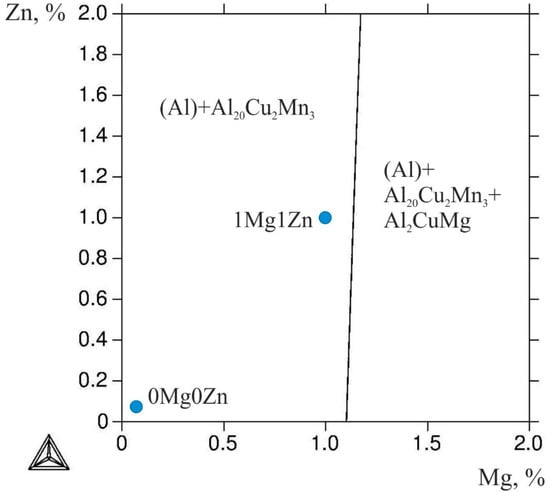
Figure 1.
The isothermal section of Al–Cu–Mn–Mg–Zn phase diagram at 2%Cu, 1.5%Mn, and 400 °C with marked experimental alloys.
The alloys were melted in a resistance furnace (GRAFICARBO) using a graphite-chased crucible. To obtain the selected composition, we used pure metals (99.85% aluminum, 99.9% copper, 99.9% magnesium, 99.9% zinc, and Al–10%Mn master alloy. When the material batch had melted, we held it for about 10 min for homogenization and then poured it into a flat graphite mold 10 mm × 40 mm × 180 mm in size at 750 °C. The cooling rate during solidification was approximately 20 K/s. The chemical composition of the experimental alloys according to spectral analysis (Oxford Instruments, Oxfordshire, UK) is given in Table 1. It can be seen that the actual compositions were close to the target ones.

Table 1.
Chemical compositions of experimental alloys.
Ingots of experimental alloys were subjected to hot rolling at 400 °C. Before rolling, the ingots were annealed at 400 °C and held for 1 h. Then, the ingots were rolled to a thickness of 2 mm (compression ratio of 80%). Then, the hot-rolled sheets were annealed at 350 °C for 3 h, and then cold-rolled to a thickness of 0.5 mm (compression ratio 75%). The cold-rolled sheet products were prepared using a laboratory-scale rolling mill machine (Chinetti LM160). To evaluate the effect of annealing on the structure and hardness, the semi-finished products were further subjected to stepwise annealing in accordance with the processing route shown in Table 2.

Table 2.
Processing routes for experimental alloys.
The microstructure was examined by optical microscopy (OM, Axio Observer MAT), transmission electron microscopy (TEM, JEM-2100), scanning electron microscopy (SEM, TESCAN VEGA 3), and electron microprobe analysis (EMPA, OXFORD AZtec). The samples were prepared using mechanical and electrolytic polishing. Electrolytic polishing was carried out at a voltage of 12 V in an electrolyte (6 C2H5OH, 1 HClO4, and 1 glycerine). Initial microstructural observations were carried out using OM, and detailed studies were then performed using SEM and TEM. Thin foils for TEM were prepared by ion thinning with the PIPS technique (Precision Ion Polishing System, Gatan, Pleasanton, USA) and studied at 160 kV. X-ray diffraction (XRD) data were obtained using CuKα radiation and treated with a software package [33]. The objects of the XRD study were polished samples of the 0Mg0Zn and 1Mg1Zn alloys cut from part of the cold-rolled sheets in the state CR400 (Table 2).
The Vickers hardness (HV) was measured using a DUROLINE MH-6 setup (METKON Instruments, Bursa, TURKEY) with a load of 1 kg and a dwell time of 10 s. At least five measurements were performed for each sample. The specific electrical conductivity (EC) of the ingots and hot-rolled sheets (2 mm) was determined using the eddy current method with a VE-26NP eddy structure scope. Room-temperature tensile tests were conducted for the cold-rolled sheets (0.5 mm) using an Instron 5966 machine. The loading rate was 10 mm/min.
The phase composition of the Al–Cu–Mn–Mg–Zn (Fe,Si) system (isothermal sections, fractions of phases, and (Al) composition in the experimental alloys) was calculated using Thermo-Calc software (TTAL5 database [34].
3. Experimental Results
3.1. Phase Composition and Microstructure of the Ingots
The existence of a tiny quantity of Cu-containing phase crystals created as a result of nonequilibrium solidification is a common feature of the alloys’ as-cast structures. These crystals are located along the boundaries of the dendritic cells in the primary crystals of the aluminum solid solution (hereinafter (Al)). In the reference alloy, they are represented by the Al2Cu phase (Figure 2a), and in the 1Mg1Zn alloy, by the Al2CuMg phase (Figure 2b). In addition, a small amount of Fe-containing phase crystals is present in the as-cast structure due to the presence of iron impurities in primary aluminum used for alloy preparation (Table 1). According to the EDS data, they are identified as Al15(Mn,Fe)3Si2 in the base alloy (Figure 2a), and as Al6(Mn,Fe) in the 1Mg1Zn alloy (Figure 2b). Almost the entire amount of manganese in both alloys is in (Al). Zinc (in the 1Mg1Zn alloy) is completely dissolved in (Al), while magnesium and copper are partially dissolved (because they form eutectic particles of the Al2Cu and Al2CuMg phases). In general, the microstructure of the alloy with magnesium and zinc additions differs but only a little from the microstructure of the base alloy, the ingots of which, as was shown earlier [26,27,28,32], have a sufficiently high deformation processability.
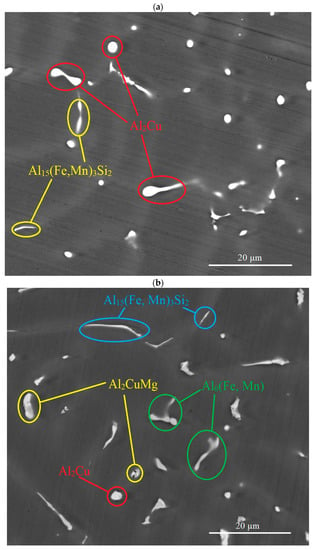
Figure 2.
Microstructure of experimental alloys in ingots (F), SEM: (a) 0Mg0Zn, (b) 1Mg1Zn.
3.2. Microstructure and Phase Composition of Hot-Rolled Sheets
Sheets of the alloys were obtained by hot rolling. Analysis of the microstructure of the hot-rolled sheets showed that the particles of Fe-containing phases formed during casting (Figure 2) and were preserved after rolling (Figure 3) due to the low solubility of iron in (Al). The number of Al2Cu and Al2CuMg particles somewhat decreased, since magnesium and copper partially dissolved in (Al) during heating at 400 °C (before and during rolling). In addition, heating at this temperature led to both partial decomposition of (Al) and the formation of Al20Cu2Mn3 phase dispersoids, the size of which, according to [26,27,28,32], does not exceed 100 nm, and therefore they cannot be detected in Figure 3. Annealing of the hot-rolled sheets at 300 °C and 350 °C had almost no effect on their structure. After 3 h of annealing at 400 °C (state HR400, see Table 2), almost complete dissolution of copper, magnesium, and zinc (the last two elements in the 1Mg1Zn alloy) took place. XRD analysis confirms the presence of the Al20Cu2Mn3 compound in both alloys in about the same quantity (Figure 4). With an increase in the annealing temperature to 500 °C, the phase composition of the alloys did not change qualitatively; however, the Al20Cu2Mn3 dispersoids coarsened. Therefore, the latter is detected in the structure by the SEM method, which is shown in Figure 5.
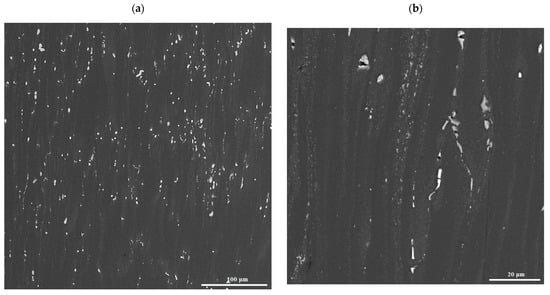
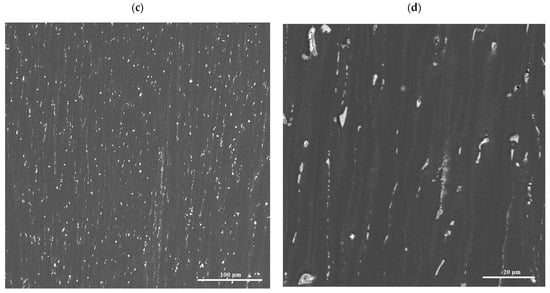
Figure 3.
Microstructure of experimental alloys in hot rolled sheets (HR), SEM: (a,b) 0Mg0Zn (c,d) 1Mg1Zn, (b,d) are the magnified SEM images of (a,b).
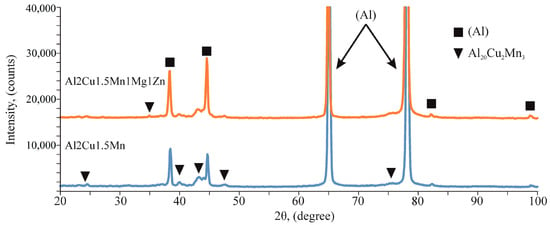
Figure 4.
XRD data for experimental alloys in cold rolled sheets after annealing at 400 °C (CR400).
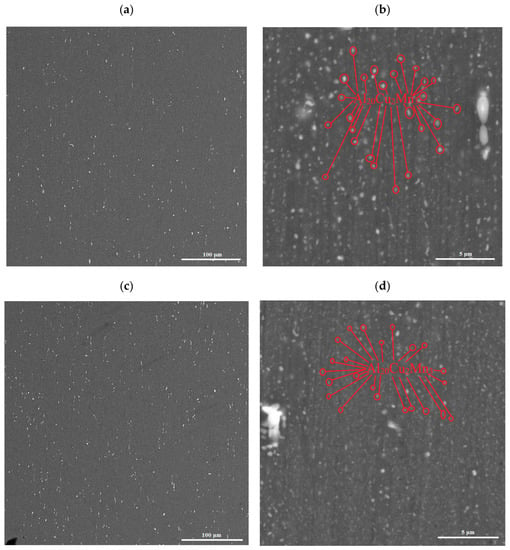
Figure 5.
Microstructure of experimental alloys in hot rolled sheets after annealing at 500 °C (HR500), SEM: (a,b) 0Mg0Zn, (c,d) 1Mg1Zn, (b,d) are the magnified SEM images of (a,b).
3.3. Hardness and Electrical Resistivity of Hot-Rolled Sheets
As can be seen from Figure 6a, magnesium and zinc additions have a hardening effect for all states of the processed alloy. The greatest difference in the hardness compared to the reference alloy is observed in the as-cast state (~20 HV). After hot rolling, it decreases to 13 HV, and after annealing at 300 °C to 7 HV. As the annealing temperature increases, the difference in the hardness values starts to increase, reaching 16 HV in the HR500 condition. The reason for the increase in hardness in the 1Mg1Zn alloy is explained in the Discussion section, where it is shown that the obtained result is due to the solid solution hardening.
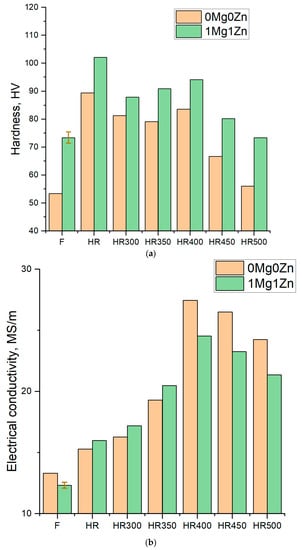
Figure 6.
Change in (a) hardness (HV) and (b) electrical conductivity (EC) of hot rolled sheet alloys during stepwise annealing in accordance with the processing route shown in Table 2.
Changes in the EC value agree well with the changes occurring in the microstructure, i.e., primarily dissolution and precipitation. Since manganese has the strongest influence on the EC, the difference between the alloys in the EC is smaller than the difference in the hardness. It can be seen from Figure 6b that both alloys have the lowest EC values in the as-cast state, since all the manganese is in (Al). After hot rolling and subsequent annealing at up to 450 °C inclusively, the concentration of Mn in (Al) decreases, and the EC values increase accordingly. The decrease in the EC in the HR500 state is caused by an increase in the concentration of Mn in (Al) at an elevated annealing temperature. The latter fact is consistent with previous studies of the Al–Cu–Mn alloys [26,27,28,32].
3.4. SEM and TEM Structure of Cold-Rolled Sheets
Taking into account that in order to increase the strength properties, it is necessary to obtain a minimum size of the Al20Cu2Mn3 phase dispersoids (preferably not larger than 100 nm [26,27,28,32]), the initial hot-rolled sheets were preliminarily annealed at 350 °C for 3 h before cold rolling. This annealing proved to be sufficient to obtain high-quality cold-rolled sheets with a thickness of 0.5 mm (compression ratio 75%). Since inclusions of eutectic Cu-containing particles still remain in the structure of the hot-rolled sheets, they are detected in the structure after cold rolling along with the Fe-containing phases (Figure 7a,b). In this case, the morphology of these particles is improved due to their fragmentation during deformation. Figure 7c,d illustrate that both alloys, after annealing at 400 °C, have a non-recrystallized structure.
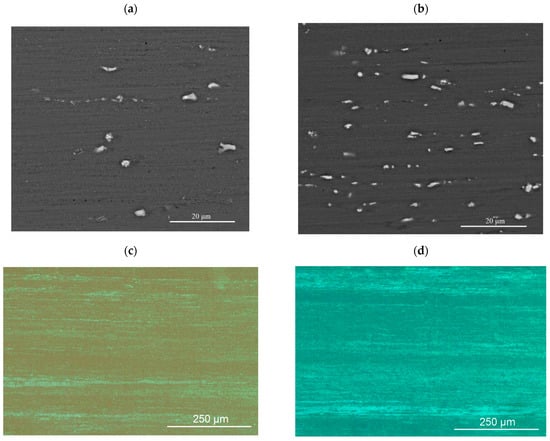
Figure 7.
Microstructure of experimental alloys: (a,c) 0Mg0Zn CR, (b,d) 1Mg1Zn after cold rolling (a,b) and cold rolling and annealing at 400 °C (c,d). (a,b) SEM, (c,d) OM (polarized light).
Cold rolling leads to an increase in the dislocation density and the formation of a cell structure, which can be seen in the example of the 1Mg1Zn alloy in Figure 8a. Dispersoids of the Al20Cu2Mn3 phase with a size not exceeding 100 nm (Figure 8b) are also detected. Annealing at 350 °C leads to the formation of subgrains about 1 µm in size with partial preservation of the cell dislocation structure (Figure 8c). The amount of Al20Cu2Mn3 dispersoids increases, and they are more clearly detected (Figure 8d). After annealing at 400 °C, a completely non-recrystallized structure is preserved in both alloys (Figure 7c,d). The subgrain size in the 1Mg1Zn alloy remains at about 1 µm (Figure 8e), the dislocation density still being quite high in some regions (Figure 8f). The size of most dispersoids remains at less than 100 nm, with only a few of them growing up to 150–200 nm (Figure 8g). Obviously, Al20Cu2Mn3 disperoids prevent recrystallization and subgrain growth (Figure 8h).
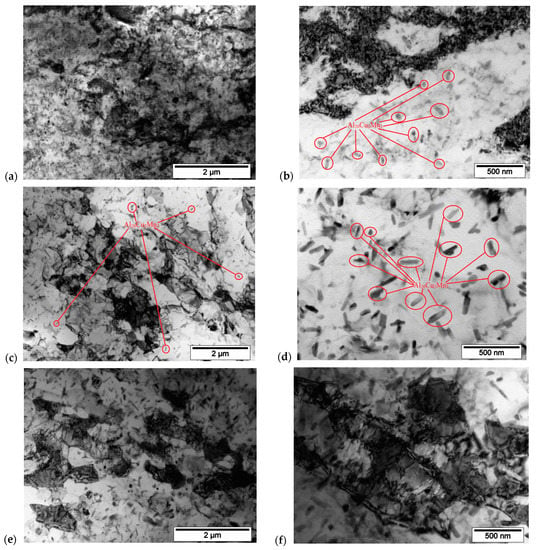
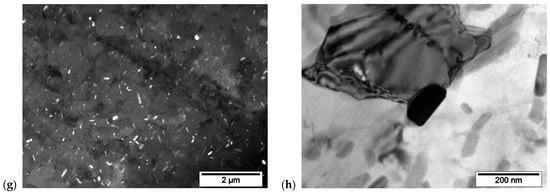
Figure 8.
TEM structures of cold rolled sheet alloy 1Mg1Zn: (a,b) CR, (c,d) CR350, (e–h) CR400; (a–e,g,h) bright field, (f) dark field and diffraction patterns, (b,d,h,f) are the magnified TEM images of (a,c,e,g).
3.5. Mechanical Properties of Cold-Rolled Sheets
Table 3 presents the results of tensile testing of cold-formed sheets in the initial state (CR) and after single-stage 3-h annealing at 350 °C (CR350) and 400 °C (CR400). It can be seen from the results that magnesium and zinc addition in the CR state significantly increases the tensile strength and yield strength, while the elongation remains at the same low level as for the base alloy. However, the CR350 and CR400 states in which a relatively stable structure is formed are more indicative. Annealing reduces the strength and increases the ductility of both alloys; however, the degree of change varies greatly. The strength properties of the 1Mg1Zn alloy are approximately 15% higher than those in the base alloy with close plasticity (examples of engineering stress–strain curves are given in Figure 9). Since there is almost no difference in the mechanical properties between the CR350 and CR400 states, the latter seems to be preferable since it exhibits a greater stabilization of the structure.

Table 3.
Mechanical properties of cold rolled sheets (0.5 mm).
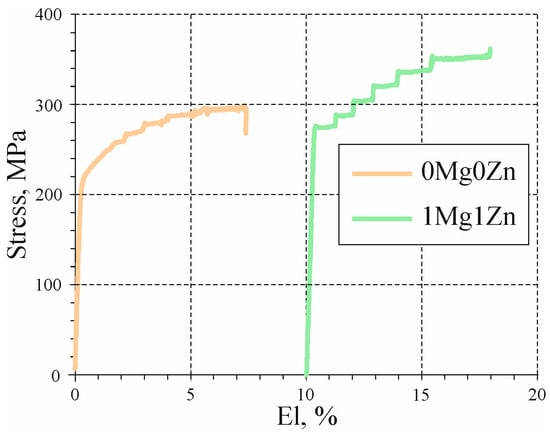
Figure 9.
Typical tensile engineering stress–strain curves of experimental alloys obtained after cold rolling and annealing at 400 °C (CR400).
Fracture surface analysis of the alloys showed a dimple structure both in the initial and as-annealed states (Figure 10). However, the number of dimples in the as-annealed state (Figure 10c,d) is much larger, and their size is smaller, which is obviously associated with a greater deformation before fracture.
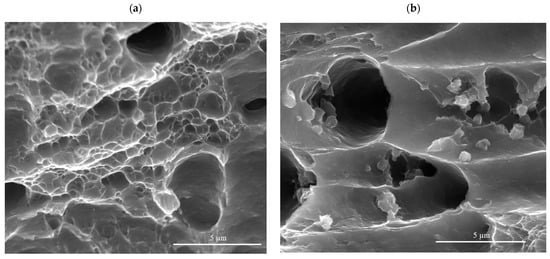

Figure 10.
The fracture surface of cold rolled sheets after tensile test, SEM: (a,b) cold rolled, (c,d) annealed at 400 °C after cold rolling. (a,c) 0Mg0Zn, (b,d) 1Mg1Zn.
4. Discussion
The experimental results show that the joint addition of 1%Mg and 1%Zn to the base alloy significantly increases the UTS and YS of the cold-rolled sheets annealed at 400 °C (Figure 11). At the same time, the plasticity decreases, but only a little. To explain this effect, we analyzed the differences in the structure and phase composition between the 0Mg0Zn and 1Mg1Zn alloys.
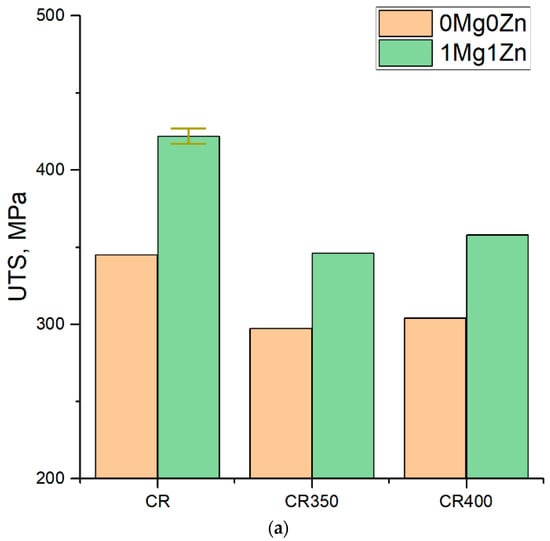

Figure 11.
Comparison of mechanical properties: (a) UTS, (b) YS, (c) El.
Previous studies of the related Al–Cu–Mn alloys [25] suggest that annealing at 400 °C or higher makes it possible to obtain a close-to-equilibrium state. Calculations of the equilibrium phase composition were carried out for the test alloys (the iron impurity was not taken into account). As can be seen from Table 4, the amount of the Al20Cu2Mn3 phase in all the alloys is approximately the same (about 6.5 wt.%). It follows from this fact that magnesium and zinc addition should not affect the number of nanosized dispersoids of this ternary compound, which are formed during the deformation heat treatment and determine the strength and heat resistance of the base alloy [25]. According to the calculations, magnesium and zinc in the 1Mg1Zn alloy are completely dissolved in (Al) at 400 °C or higher temperatures (Table 5). This is the main difference in the phase composition between the 0Mg0Zn and 1Mg1Zn alloys.

Table 4.
Calculated fractions of phases for experimental alloys at various temperatures.

Table 5.
Calculated composition of aluminum solid solution for experimental alloys at various temperatures.
Assuming that different strengthening mechanisms, such as solid solution strengthening (σss), grain boundary strengthening (σgb), dislocations strengthening (σρ), and second phase strengthening (σpp) have independent contributions in the YS of the alloy, the latter can be calculated as follows [35]:
The base yield strength, σ0 (~20 MPa).
The solid solution strengthening caused by Zn and Mg can be determined as follows [36]:
where ki is the coefficient describing the effect of atomic solute on solid solution strengthening; the corresponding strengthening coefficients of Zn, Mg, and Cu are 3.085, 20.081, and 12.431, respectively [37]; Ci is the weight percentage of atomic solute in the matrix. Taking into account that for the 1Mg1Zn alloy in question CZn = 1.20 wt.%, CMg = 1.07 wt.%, and Ccu = 1.09 wt.% (Table 5), σssZn is ~3.5 MPa, σssMg is ~21 MPa, σssCu is ~13.1 MPa, and the total σss is ~37.6.
The contribution of grain boundary strengthening to the YS can be calculated using the Hall–Patch equation which can be expressed as [38].
where σ0 is the intrinsic resistance of the lattice to dislocation motion, which is approximately 20 MPa for most aluminum alloys; k = 0.14 MPa·m1/2 is the Hall–Petch coefficient [38], and D is the average grain or sub-grain sizes. From the structural analysis data, the average size of sub-grain boundaries is 0.45 μm (Figure 8). From the latter fact, the value of is ~228 MPa.
The strengthening effect caused by the Al20 phase can be assessed using the following modified Orowan equations for rod-like particles of diameter Dr and length lr (>>Dr) [39,40]:
where G = 25.4 GPa is the shear modulus; b = 0.286 nm is the Burgers vector; fv is the volume fraction of the dispersed phase; Dr is the rod diameter (according to metallographic analysis, Dr is 40 nm); and r0 is the inner cut-off radius for the calculation of the dislocation line tension. According to the aforementioned calculation (Equation (4)), the increase in the yield strength is 10.5 MPa.
According to the calculations, the total value of the YS is 296 MPa, which is quite close to the experimental data of 280 MPa (taking into account the measurement error, Figure 12). According to Table 3, the difference in the YS between the 0Mg0Zn and 1Mg1Zn alloys is about 42 MPa, which is very close to the calculated data of solid solution hardening: σss is ~37.6 MPa. Thus, the results show that the addition of 1% magnesium and zinc to the base alloy can be considered a promising method of increasing the strength of rolled sheets while maintaining the main advantage, namely, the exclusion of homogenization and quenching operations from the process route.
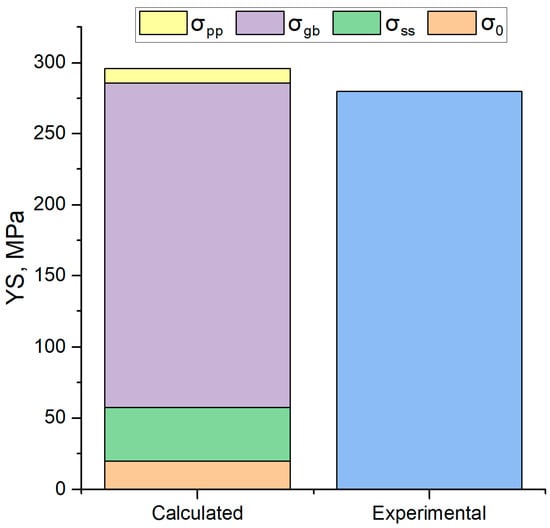
Figure 12.
Comparison of calculated and measured yield strength for the cold-rolled 1Mg1Zn alloy and fraction of different strengthening mechanisms in the total YS.
The experimental results show that despite both the commercial (2xxx) and experimental alloys having the same alloying system (Al–Cu–Mn(–Mg)), their properties and microstructure constitutions are very different. This circumstance stems from the fact that the commercial alloys were designed for a maximum number of precipitates forming at aging [41,42], while the model alloy Al2Cu1.5Mn1Mg1Zn provides a high fraction (much higher than those for the commercial alloys) of Al20Cu2Mn3 dispersoids.
Recently, several works were published where authors argued that the increase in the thermal stability of the 2xxx alloys is possible via microalloying with Ag [43], Sc, and Zr [44,45,46]. Although this way can lead to some increase in heat resistance through stabilization of the θ′ phase, it is limited in terms of temperature. For instance, work [45] studied the influence of Sc and Zr micro additions on the high-temperature strength of the AA2219-type composition. However, no temperatures higher than 280 °C are considered in this study. Moreover, the high cost of Sc limits the wide industrial application of such alloys.
From the data obtained, one can conclude that the Al2Cu1.5Mn1Mg1Zn-based model alloy is very promising for the designing of new wrought heat-resistant aluminum alloys. The new alloy is notably superior to commercial ones (particularly, 2219, 2024, 2014) in thermal stability (toward softening at heating up to 400 °C) and provides a much shorter technological routine (the stages of homogenization, solution treatment, and water quenching are excluded) to obtain the wrought products. In addition, the new alloys can be prepared from secondary raw materials containing a typical set of elements (i.e., Cu, Mg, Zn, Mn, Fe, and Si) [32].
5. Summary
Sheet model alloys Al2Cu1.5Mn and Al2Cu1.5Mn1Mg1Zn (wt.%) designed for Al20Cu2Mn3 dispersoids were compared in phase composition, microstructure, and mechanical properties after different processing routes (including hot rolling, cold rolling, and annealing). The conclusions are shown in the following points:
1. It was shown using calculation and experimental methods that the alloys contain approximately equal volume fractions (~7 vol.%) of Al20Cu2Mn3 dispersoids after annealing at 350–450 °C. The main difference between them is in the composition of the aluminum solid solution (Al), because Mg and Zn are almost fully dissolved in (Al);
2. The formation of nanosized Al20Cu2Mn3 dispersoids was found to provide for the preservation of the fiber-like (non-recrystallized) grain structure after annealing at up to 400 °C for (3 h), despite a high cold-rolling reduction ratio (80%);
3. The Al2Cu1.5Mn1Mg1Zn model alloy showed a substantially higher strength performance after annealing at 400 °C in comparison with the reference ternary alloy. In particular, the UTS is ~360 vs. ~300 MPa, and the YS is 280 vs. 230 MPa. This indicates a positive effect of Mg and Zn dissolved in (Al) on the strength;
4. Summing up the results, the Al2Cu1.5Mn1Mg1Zn model alloy shows potential to become the basis for designing new high-tech heat-resistant alloys as a sustainable alternative to the 2xxx alloys.
Author Contributions
Conceptualization, N.B.; investigation, K.T. and A.F.; methodology, N.L. and T.A.; supervision, N.B.; writing—original draft, N.B.; investigation, A.F., Writing—review and editing, T.A. All authors have read and agreed to the published version of the manuscript.
Funding
The authors gratefully acknowledge the financial support of the Russian Science Foundation (Project No. 20-19-00249-P) (Conceptualization, SEM, hardness and electrical conductivity tests, tensile tests, discussion) and financial support by the Moscow Polytechnic University within the framework of the grant named after Pyotr Kapitsa (TEM, Thermo-Calc calculations).
Data Availability Statement
The raw/processed data required to reproduce these findings cannotbe shared at this time due to technical or time limitations.
Acknowledgments
The results were obtained by using the equipment of the Center for Collective Use ‘Materials Science and Metallurgy’ with the financial support of the Ministry of Science and Higher Education of the Russian Federation (#075-15-2021-696).
Conflicts of Interest
The authors declare no conflict of interest.
References
- Jaunky, V.C. Are Shocks to Aluminium Consumption Transitory or Permanent? Rev. Appl. Econ. 2013, 9, 21–37. [Google Scholar] [CrossRef]
- Babcsán, N. Aluminium Infinite Green Circular Economy–Theoretical Carbon Free Infinite Loop, Combination of Material and Energy Cycles; Solutions for Sustainable Development; CRC Press: Boca Raton, FL, USA, 2019; pp. 205–210. [Google Scholar]
- Brough, D.; Jouhara, H. The aluminium industry: A review on state-of-the-art technologies, environmental impacts and possibilities for waste heat recovery. Int. J. Thermofluids. 2020, 1, 100007. [Google Scholar] [CrossRef]
- Ashkenazi, D. How aluminum changed the world: A metallurgical revolution through technological and cultural perspectives. Technol. Forecast. Soc. Chang. 2019, 143, 101–113. [Google Scholar] [CrossRef]
- Pedneault, J.; Majeau-Bettez, G.; Pauliuk, S.; Margni, M. Sector-specific scenarios for future stocks and flows of aluminum: An analysis based on shared socioeconomic pathways. J. Ind. Eco. 2022, 26, 1728–1746. [Google Scholar] [CrossRef]
- Ujah, C.O.; Popoola, A.P.I.; Popoola, O.M. Review on materials applied in electric transmission conductors. J. Mater. Sci. 2022, 57, 1581–1598. [Google Scholar] [CrossRef]
- Zheng, K.; Politis, D.J.; Wang, L.; Lin, J. A review on forming techniques for manufacturing lightweight complex—Shaped aluminium panel components. Int. J. Light. Mater. Manuf. 2018, 1, 55–80. [Google Scholar] [CrossRef]
- Kermanidis, A.T. Aircraft Aluminum Alloys: Applications and Future Trends. In Revolutionizing Aircraft Materials and Processes; Pantelakis, S., Tserpes, K., Eds.; Springer: Cham, Switzerland, 2020; pp. 21–55. [Google Scholar]
- Yang, C.; Zhang, L.; Chen, Z.; Gao, Y.; Xu, Z. Dynamic material flow analysis of aluminum from automobiles in China during 2000-2050 for standardized recycling management. J. Clean. Prod. 2022, 337, 130544. [Google Scholar] [CrossRef]
- Stemper, L.; Tunes, M.A.; Tosone, R.; Uggowitzer, P.J.; Pogatscher, S. On the potential of aluminum crossover alloys. Prog. Mater. Sci. 2022, 124, 100873. [Google Scholar] [CrossRef]
- Asadikiya, M.; Yang, S.; Zhang, Y.; Lemay, C.; Apelian, D.; Zhong, Y. A review of the design of high-entropy aluminum alloys: A pathway for novel Al alloys. J. Mater. Sci. 2021, 56, 12093–12110. [Google Scholar] [CrossRef]
- Raabe, D.; Ponge, D.; Uggowitzer, P.; Roscher, M.; Paolantonio, M.; Liu, C.; Antrekowitsch, H.; Kozeschnik, E.; Seidmann, D.; Gault, B.; et al. Making sustainable aluminium by recycling scrap: The science of “dirty” alloys. Prog. Mater. Sci. 2022, 128, 100947. [Google Scholar] [CrossRef]
- Arowosola, A.; Gaustad, G. Estimating increasing diversity and dissipative loss of critical metals in the aluminum automotive sector. Resour. Conserv. Recycl. 2019, 150, 104382. [Google Scholar] [CrossRef]
- Capuzzi, S.; Timelli, G. Preparation and melting of scrap in aluminum recycling: A review. Metals 2018, 8, 249. [Google Scholar] [CrossRef]
- Niu, G.; Wang, J.; Ye, J.; Mao, J. Enhancing Fe content tolerance in A356 alloys for achieving low carbon footprint aluminum structure castings. J. Mater. Sci. Technol. 2023, 161, 180–191. [Google Scholar] [CrossRef]
- Polmear, I.; StJohn, D.; Nie, J.F.; Qian, M. Light Alloys: Metallurgy of the Light Metals, 5th ed.; Elsevier, Butterworth-Heinemann: Oxford, UK, 2017; pp. 31–107. [Google Scholar] [CrossRef]
- Mondol, S.; Alam, T.; Banerjee, R.; Kumar, S.; Chattopadhyay, K. Development of a high temperature high strength Al alloy by addition of small amounts of Sc and Mg to 2219 alloy. Mater. Sci. Eng. A 2017, 687, 221–231. [Google Scholar] [CrossRef]
- He, H.; Yi, Y.; Huang, S.; Zhang, Y. Effects of cold predeformation on dissolution of second-phase Al2Cu particles during solution treatment of 2219 Al-Cu alloy forgings. Mater. Charact. 2018, 135, 18–24. [Google Scholar] [CrossRef]
- Zuiko, I.; Kaibyshev, R. Aging behavior of an Al–Cu–Mg alloy. J. Alloys Compd. 2018, 759, 108–119. [Google Scholar] [CrossRef]
- de Sousa Araujo, J.V.; Milagre, M.X.; Ferreira, R.O.; de Souza Carvalho Machado, C.; de Abreu, C.P.; Costa, I. Microstructural characteristics of the Al alloys: The dissimilarities among the 2XXX alloys series used in aircraft structures. Metallogr. Microstruct. Anal. 2020, 9, 744–758. [Google Scholar] [CrossRef]
- Kumar, N.S.; Pramod, G.K.; Samrat, P.; Sadashiva, M. A critical review on heat treatment of aluminium alloys. Mater. Today Proc. 2022, 58, 71–79. [Google Scholar] [CrossRef]
- Sirichaivetkul, R.; Limmaneevichitr, C.; Tongsri, R.; Kajornchaiyakul, J. Isothermal Investigation and Deformation Behavior during Homogenization of 6063 Aluminum Alloy. J. Mater. Eng. Perform. 2023, 32, 638–650. [Google Scholar] [CrossRef]
- Rinderer, B. The metallurgy of homogenization. Mater. Sci. Forum. 2011, 693, 264–275. [Google Scholar] [CrossRef]
- Ber, L.B.; Kolobnev, N.I.; Tsukrov, S.L. Heat Treatment of Aluminum Alloys, 1st ed.; CRC Press: Boca Raton, FL, USA, 2020. [Google Scholar]
- Belov, N.A.; Akopyan, T.K.; Shurkin, P.K.; Korotkova, N.O. Comparative analysis of structure evolution and thermal stability of experimental AA2219 and model Al-2wt.%Mn-2wt.%Cu cold rolled alloys. J. Alloys Compd. 2021, 864, 158823. [Google Scholar] [CrossRef]
- Belov, N.A.; Alabin, A.N.; Matveeva, I.A. Optimization of phase composition of Al–Cu–Mn–Zr–Sc alloys for rolled products without requirement for solution treatment and quenching. J. Alloys Compd. 2014, 583, 206–213. [Google Scholar] [CrossRef]
- Belov, N.A.; Korotkova, N.O.; Akopyan, T.K.; Tsydenov, K.A. Simultaneous Increase of Electrical Conductivity and Hardness of Al–1.5 wt.% Mn Alloy by Addition of 1.5 wt.% Cu and 0.5 wt.% Zr. Metals 2019, 9, 1246. [Google Scholar] [CrossRef]
- Belov, N.A.; Akopyan, T.K.; Korotkova, N.O.; Timofeev, V.N.; Shurkin, P.K. Effect of cold rolling and annealing temperature on structure, hardness and electrical conductivity of rapidly solidified alloy of Al–Cu–Mn–Zr system. Mater. Lett. 2021, 300, 130199. [Google Scholar] [CrossRef]
- Korotkova, N.O.; Shurkin, P.K.; Cherkasov, S.O.; Aksenov, A.A. Effect of Copper Concentration and Annealing Temperature on the Structure and Mechanical Properties of Ingots and Cold-Rolled Sheets of Al–2% Mn Alloy. Russ. J. Non-Ferr. Met. 2022, 63, 190–200. [Google Scholar] [CrossRef]
- Dar, S.M.; Liao, H. Creep behavior of heat resistant Al–Cu–Mn alloys strengthened by fine (θ′) and coarse (Al20Cu2Mn3) second phase particles. Mater. Sci. Eng. A 2019, 763, 138062. [Google Scholar] [CrossRef]
- Mikhaylovskaya, A.V.; Mukhamejanova, A.; Kotov, A.D.; Tabachkova, N.Y.; Prosviryakov, A.S.; Mochugovskiy, A.G. Precipitation Behavior of the Metastable Quasicrystalline I-Phase and θ′-Phase in Al-Cu-Mn Alloy. Metals 2023, 13, 469. [Google Scholar] [CrossRef]
- Belov, N.A.; Cherkasov, S.O.; Korotkova, N.O.; Yakovleva, A.O.; Tsydenov, K.A. Effect of Iron and Silicon on the Phase Composition and Microstructure of the Al–2% Cu–2% Mn (wt%) Cold Rolled Alloy. Phys. Met. Metallogr. 2021, 122, 1095–1102. [Google Scholar] [CrossRef]
- Shelekhov, E.V.; Sviridova, T.A. Programs for X-ray analysis of polycrystals. Met. Sci. Heat Treat. 2000, 42, 309–313. [Google Scholar] [CrossRef]
- Thermo-Calc Software. Available online: http://www.thermocalc.com (accessed on 27 June 2023).
- Tian, A.; Sun, L.; Deng, Y.; Yuan, M. Study of the Precipitation Kinetics, Microstructures, and Mechanical Properties of Al-Zn-Mg-xCu Alloys. Metals 2022, 12, 1610. [Google Scholar] [CrossRef]
- Cinkilic, E.; Yan, X.; Luo, A.A. Modeling Precipitation Hardening and Yield Strength in Cast Al-Si-Mg-Mn Alloys. Metals 2020, 10, 1356. [Google Scholar] [CrossRef]
- Dixit, M.; Mishra, R.S.; Sankaran, K.K. Structure–property correlations in Al 7050 and Al 7055 high-strength aluminum alloys. Mater. Sci. Eng. A 2008, 478, 163–172. [Google Scholar] [CrossRef]
- Thangaraju, S.; Heilmaier, M.; Murty, B.S.; Vadlamani, S.S. On the Estimation of True Hall–Petch Constants and Their Role on the Superposition Law Exponent in Al Alloys. Adv. Eng. Mater. 2012, 14, 892–897. [Google Scholar] [CrossRef]
- Zhu, A.W.; Starke, E.A. Strengthening effect of unshearable particles of finite size: A computer experimental study. Acta Mater. 1999, 47, 3263–3269. [Google Scholar] [CrossRef]
- Starink, M.J.; Wang, S.C. A model for the yield strength of overaged Al–Zn–Mg–Cu alloys. Acta Mater. 2003, 51, 5131–5150. [Google Scholar] [CrossRef]
- Çadırlı, E.; Kaya, H.; Büyük, U.; Üstün, E.; Gündüz, M. Effect of heat treatment on the microstructures and mechanical properties of Al–4Cu–1.5 Mg alloy. Int. J. Metalcast. 2022, 16, 1020–1033. [Google Scholar] [CrossRef]
- Liang, S.S.; Wen, S.P.; Wu, X.L.; Huang, H.; Gao, K.Y.; Nie, Z.R. The synergetic effect of Si and Sc on the thermal stability of the precipitates in AlCuMg alloy. Mater. Sci. Eng. A 2020, 783, 139319. [Google Scholar] [CrossRef]
- Zamani, M.; Toschi, S.; Morri, A.; Ceschini, L.; Seifeddine, S. Optimisation of heat treatment of Al–Cu–(Mg–Ag) cast alloys. J. Therm. Anal. Calorim. 2020, 139, 3427–3440. [Google Scholar] [CrossRef]
- Kairy, S.K.; Rouxel, B.; Dumbre, J.; Lamb, J.; Langan, T.J.; Dorin, T.; Birbilis, N. Simultaneous improvement in corrosion resistance and hardness of a model 2xxx series Al-Cu alloy with the microstructural variation caused by Sc and Zr additions. Corros. Sci. 2019, 158, 108095. [Google Scholar] [CrossRef]
- Mondol, S.; Kashyap, S.; Kumar, S.; Chattopadhyay, K. Improvement of high temperature strength of 2219 alloy by Sc and Zr addition through a novel three-stage heat treatment route. Mater. Sci. Eng. A 2018, 732, 157–166. [Google Scholar] [CrossRef]
- Mondol, S.; Kumar, S.; Chattopadhyay, K. Effect of thermo-mechanical treatment on microstructure and tensile properties of 2219ScMg alloy. Mater. Sci. Eng. A 2019, 759, 583–593. [Google Scholar] [CrossRef]
Disclaimer/Publisher’s Note: The statements, opinions and data contained in all publications are solely those of the individual author(s) and contributor(s) and not of MDPI and/or the editor(s). MDPI and/or the editor(s) disclaim responsibility for any injury to people or property resulting from any ideas, methods, instructions or products referred to in the content. |
© 2023 by the authors. Licensee MDPI, Basel, Switzerland. This article is an open access article distributed under the terms and conditions of the Creative Commons Attribution (CC BY) license (https://creativecommons.org/licenses/by/4.0/).